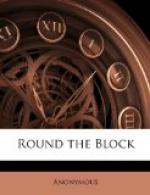“Happy to meet a confidential friend of Tiffles’s,” said Patching. “Painting panoramas is not exactly what I have been used to. An artist’s reputation is his capital in trade, you know.” He spoke slowly and languidly, as if hope and happiness were quite dead within him, and he had consented to live on only for the good of high Art.
“I understand,” said Marcus. “The secret shall be inviolate.”
“Nothing but my old friendship for Tiffles here could possibly have induced me to undertake the job. My enemies—and I have them, ha! ha!” (he said this bitterly)—“would like nothing better to say of Patching, than that he had got down to the panorama line of business. It would be a pretty piece of scandal.”
“My lips are sealed, sir. But it strikes me, as a casual observer, that there is nothing to be ashamed of in this beautiful work of art.” Marcus Wilkeson had the amiable vice of flattery.
Patching shrugged his shoulders, and made a contemptuous gesture toward the canvas with his outstretched brush. “A mere daub,” said he. “One step higher than painting a barn or a board fence—that’s all.”
“Yet the true artist adorns what he touches,” said Marcus.
Patching accepted the homage calmly, as one who knew that he deserved it. “A very just and discriminating remark, sir. I have no doubt that a person thoroughly familiar with my style would say, looking at this panorama, ‘It has the severe simplicity of a Patching.’ I consented to paint it, as Tiffles well remembers, only on condition that I should not wholly abase myself by abandoning the style upon which I have built up my reputation.”
Tiffles, thus appealed to, corroborated the statement with a solemn bow.
The artist continued: “Fortunately, the subject is one peculiarly adapted to my genius. For instance: the desert of Sahara is a dead level of sand. It is a perfect type of severe simplicity in the highest sense. It exhibits no common display of gorgeous colors, such as poor artists and the ignorant crowd rejoice in. As far as the eye can see, there is a serene stretch of yellow sand, without even a blade of grass to break its awful immensity.” (The artist, being on his favorite theme, took his pipe out of his mouth for the first time, and spoke with warmth.) “Look at that bit of desert, now. Does it not convey a perfect idea of solitude and desolation?”
Marcus Wilkeson glanced at about ten feet of straight yellow paint (which was all of the desert of Sahara not rolled up in the canvas), and said that it did—which was perfectly true.
“There are one hundred feet more, which you don’t see, just like it. Another artist would have put in an oasis, or a stray hyena, or the bleached bones of an unfortunate traveller. I did not. Why? Another would have worked up a sunset, or a moonrise, or a thunder storm, to give variety to the sky. I did not. Why? The sky over my desert is an uninterrupted blue. There is not even a bird in it. There is nothing, in short, either on the ground or in the air, to take away the mind of the spectator, for one moment, from the sublime idea of a desert—an object which, considered aesthetically, is one of the grandest in the universe. This is severe simplicity. It is the highest school of Art.”




